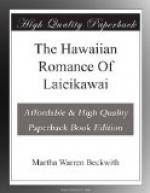[Footnote 4: Prenatal infanticide, omilomilo, was practiced in various forms throughout Polynesia even in such communities as rejected infanticide after birth. The skeleton of a woman, who evidently died during the operation, is preserved in the Bishop Museum to attest the practice, were not testimony of language and authority conclusive.]
[Footnote 5: The manini (Tenthis sandvicensis, Street) is a flat-shaped striped fish common in Hawaiian waters. The spawn, called ohua, float in a jellylike mass on the surface of the water. It is considered a great delicacy and must be fished for in the early morning before the sun touches the water and releases the spawn, which instantly begin to feed and lose their rare transparency.]
[Footnote 6: The month Ikuwa is variously placed in the calendar year. According to Malo, on Hawaii it corresponds to our October; on Molokai and Maui, to January; on Oahu, to August; on Kauai, to April.]
[Footnote 7: The adoption by their grandparents and hiding away of the twins must be compared with a large number of concealed birth tales in which relatives of superior supernatural power preserve the hero or heroine at birth and train and endow their foster children for a life of adventure. This motive reflects Polynesian custom. Adoption was by no means uncommon among Polynesians, and many a man owed his preservation from death to the fancy of some distant relative who had literally picked him off the rubbish heap to make a pet of. The secret amours of chiefs, too, led, according to Malo (p. 82), to the theme of the high chief’s son brought up in disguise, who later proves his rank, a theme as dear to the Polynesian as to romance lovers of other lands.]
CHAPTER II
[Footnote 8: The iako of a canoe are the two arched sticks which hold the outrigger. The kua iako are the points at which they are bound to the canoe, or rest upon it, aft and abaft of the canoe.]
[Footnote 9: The verb hookuiia means literally “cause to be pierced” as with a needle or other sharp instrument. Kui describes the act of piercing, hoo is the causative prefix, ia the passive particle, which was, in old Hawaiian, commonly attached to the verb as a suffix. The Hawaiian speech expresses much more exactly than our own the delicate distinction between the subject in its active and passive relation to an action, hence the passive is vastly more common. Mr. J.S. Emerson points out to me a classic example of the passive used as an imperative—an old form unknown to-day—in the story of the rock, Lekia, the “pohaku o Lekia” which overlooks the famous Green Lake at Kapoho, Puna. Lekia, the demigod, was attacked by the magician, Kaleikini, and when almost overcome, was encouraged by her mother, who called out, “Pohaku o Lekia, onia a paa”—“be planted firm.” This the demigod effected so successfully as never again to be shaken from her position.]




